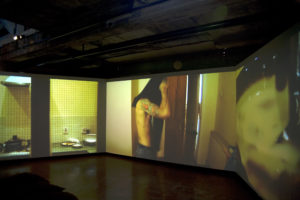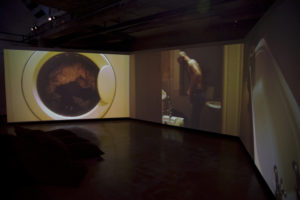Dani Marti Text for Casula catalogue
Dani Marti was born in Spain, studied in the United States and Australia, and now lives between Glasgow and the Hunter Valley, a regional town located a few hours northwest of Sydney. Mobility for Dani is as defining as his Spanish heritage, a dichotomy in constant motion, one existing as fluid movement, the other fixed on historical associations. A condition symptomatic to Globalism; a condition that at once feeds our anxieties and builds our eventual escape hatch. Dani liberates these contradictions through his art making, positioning the neo-baroque firmly within the vernacular of his practice as both weaver and video artist.
Contemporary dystopias of illusion and excess are potent within Spanish culture where Catholic guilt very much determines the course of everyday life. Goya, Gaudí, Picasso, Almodóvar smack of the Deluzian catchcry that “the world does not exist outside of its expressions”. These artists mobilize the ubiquitous españoladas (historical epics of Spain) as agencies for change. For Goya this is evidenced through his Fantasy and Invention Paintings to his Black Paintings and Disasters; Gaudi through his gothic architectural works; Picasso via Guernica and Almodóvar by his cinematic pastiches of contemporary Spanish life – AIDS, transvestitism, sexual identity, gender, religion, faith, friendship and existentialism.
Dani Marti’s works take their nod and function like españoladas. Epic in scale and labour, they unpack the tactility of time. To think through Dani’s woven works alongside his video installations conjures this sense of enduring time, where time emerges triumphant. 5 minutes of video footage equates to 100’s of metres of DV tape – lengths of time stitched and woven to materialise as portraiture. The betrayal of cinema with its loci firmly positioned on the “surface” – is causal to the seduction of audiences, however vacated in Dani’s video works. The extreme proximity to his subjects ensures an abstraction of form, a liberating force for artist, subject and audience.
The armature of Dani’s woven works, like Almodóvar’s cinema – ensure that these “expressions” exist both in and of the world. The labour intensive and repetitious processes of weaving lengths of materials specific to a certain time and place rest analogous to the recording processes of a specific time and place. Dani’s proximity to his subjects via his woven and video projects questions the illusion of intimacy. Familial, random, known and anonymous, these “subjects” are liberated from themselves through the conceptual and formal processes of Dani’s practice, collapsing time, space and place.
Encountering Dani’s works requires a mediation of the contemporary condition of Globalism and its ensuring dichotomies of illusion and excess, pleasure and pain, progress and catastrophe – all existing as Hannah Arendt posits – as opposite faces of the same coin. The intensity felt when caught in the shadow of the sublime – caught within that moment of sublimation – works across these themes. Dani offers us a mediation of and on our circumstances suggesting an alternative to the modes communicated and prescribed by structural media spaces. These complex and emotional dialogues that centre on difference are given spaces to occupy, places to transform and times to translate. These esapañoladas of everyday life are played out against a society brimming with amnesia.
Sally Breen, Director BREENSPACE

